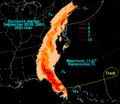Hurricane Jeanne facts for kids
| Category 3 major hurricane (SSHWS/NWS) | |

Hurricane Jeanne as a Category 3 on September 25, 2004, approaching Florida
|
|
| Formed | September 13, 2004 |
|---|---|
| Dissipated | September 28, 2004 |
| Highest winds | 1-minute sustained: 120 mph (195 km/h) |
| Lowest pressure | 950 mbar (hPa); 28.05 inHg |
| Fatalities | 3,035+ direct |
| Damage | $7 billion (2004 USD) |
| Areas affected | U.S. Virgin Islands, Puerto Rico, Dominican Republic, Haiti, Bahamas, Florida; flooding and damage in other eastern U.S. states |
| Part of the 2004 Atlantic hurricane season | |
Hurricane Jeanne was a very strong storm that formed in 2004. It was the tenth named storm and the fifth major hurricane of that year's Atlantic hurricane season. A major hurricane means it was a Category 3 or higher on the Saffir-Simpson Hurricane Wind Scale.
Jeanne caused a lot of damage and was very dangerous. It led to over 3,000 deaths, with most of these happening in Haiti. The storm also caused about $7 billion in damage, making it one of the most expensive hurricanes in U.S. history. When it reached Florida, it hit the same area that Hurricane Frances had hit just two weeks earlier.
Contents
What Happened During Hurricane Jeanne?
Hurricane Jeanne started as a tropical depression on September 13, 2004. It quickly grew stronger and became a tropical storm. As it moved west, it became a hurricane.
Jeanne's Path and Impact
Jeanne first hit Puerto Rico and the Dominican Republic. It brought heavy rains and strong winds. Then, it moved over Hispaniola, the island shared by Haiti and the Dominican Republic.
Devastation in Haiti
Haiti was hit very hard by Hurricane Jeanne. The storm caused massive floods and mudslides, especially in the city of Gonaïves. Many homes were destroyed, and roads were washed away. The floods were responsible for most of the deaths in Haiti.
Hitting Florida
After weakening to a tropical storm, Jeanne moved back over the Atlantic Ocean. It then became a hurricane again and grew much stronger. It turned towards Florida and made landfall there as a major hurricane. This happened near Stuart, Florida, which was the same place Hurricane Frances had hit earlier.
Jeanne brought strong winds, heavy rain, and storm surges to Florida. Many homes lost power, and there was a lot of damage to buildings and trees. The storm also caused tornadoes in some areas, like Delaware.
Why Hurricane Names Are Retired
Sometimes, a hurricane causes so much damage or so many deaths that its name is "retired." This means the name will never be used again for another storm. It's a way to remember the serious impact of that particular hurricane.
The name Jeanne was retired in the spring of 2005. This was because of the severe damage and the high number of people who died. The name "Julia" was chosen to replace Jeanne for future hurricane seasons, starting in 2010.
|
Tropical cyclones of the 2004 Atlantic hurricane season |
||||||||||||||||||||||||||||||||
|
|
|||||||||||||||||||||||||||||||
|
|
||||||||||||||||||||||||||||||||
Images for kids
-
Hurricane Jeanne approaching Florida on September 25, 2004.
-
A U.S. Navy member looks at a damaged sailboat in Jacksonville, Florida.
-
Damaged signs in Orlando, Florida caused by Jeanne.
-
Damage to the Vehicle Assembly Building in Florida.
See also
 In Spanish: Huracán Jeanne para niños
In Spanish: Huracán Jeanne para niños










